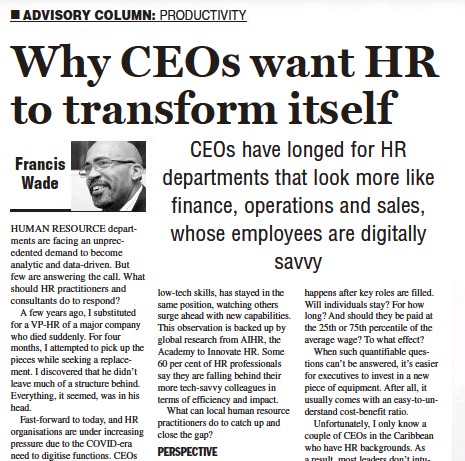Human Resource departments are facing an unprecedented demand to become analytic and data-driven. But few are answering the call. What should HR practitioners and consultants do to respond?
A few years ago, I substituted for a VP-HR of a major company who died suddenly. For four months, I attempted to pick up the pieces while seeking a replacement. I discovered that he didn’t leave much of a structure behind. Everything, it seemed, was in his head.
Fast forward to today, and HR organizations are under increasing pressure due to the COVID-era need to digitize functions. CEO’s have longed for HR Departments which look more like Finance, Operations and Sales, whose employees are digitally savvy.
Unfortunately, there are few HR teams I have worked with who have sufficient skillsets and mindsets to embrace technology, analyze data and provide dashboards. Case in point: after facilitating numerous strategic planning retreats, only a single presentation by HR stands out in these areas.
Such was the situation before COVID. Now the pandemic has widened the gap. HR, with low tech skills, has stayed in the same position, watching others surge ahead with new capabilities. This observation is backed up by global research from the Academy to Innovate HR (AIHR). Some 60% of HR Professionals say they are falling behind their more tech-savvy colleagues in terms of efficiency and impact.
What can local Human Resource Practitioners do to catch up and close the gap?
- Embrace the CEO’s Perspective
Perhaps what scares C-Suite leaders more than anything else is that the pandemic has made HR’s role more important than ever. But, it’s also annoying them at the same time. Why?
They don’t have visibility into staff-driven operations. While most agree they must make fresh investments in people to thrive in a new economy, they lack the data.
For example, while they are painfully aware of talent gaps, HR usually cannot predict what happens after key roles are filled. Will individuals stay? For how long? And should they be paid at the 25th or 75th percentile of the average wage? To what effect?
When such quantifiable questions can’t be answered, it’s easier for executives to invest in a new piece of equipment. After all, it usually comes with an easy-to-understand cost-benefit ratio.
Unfortunately, I only know a couple of CEO’s in the Caribbean who have HR backgrounds. As a result, most leaders don’t intuitively understand the invisible tradeoffs HR must make. And without data, no-one can offer a clear, numbers-driven explanation.
The solution is for HR to think like CEOs who need to implement big, fact-based decisions.
- Hire and Train
Maybe not surprisingly, the AIHR survey showed that the best place to develop such talent is at the bottom of the organization. Often, the newest and youngest employees in HR are the most digitally proficient. They are the ones who should drive improvements by picking up new capabilities and teaching them to others.
At the same time, hiring savvy mid-career HR professionals may help fill critical gaps – if they can be found. But the most difficult choices surround those HR team members who don’t have the capacity to grow fast enough. Their future might be grim as their lack of quantitative skills makes it hard for them to find employment.
All these changes add up to a major investment in talent acquisition and development within HR. However, most organizations have not recovered from the deep cuts made in training budgets during the 2008 recession. Arguably, this led to the problems we see today.
- Be Strategic
The fact is, most HR departments aren’t in a position to advocate for these investments on their own. They need the company’s entire strategic plan to call for a transformation in staff and talent in order to thrive in the future.
This kind of widespread change requires informed leadership from the top. Consequently, HR must focus on educating other executives using tools such as analytic reports and dashboards. This approach could ultimately lead to the game-changing decisions that can drive any or all other strategies the company pursues. As CEO’s know from painful experience, trying to make big changes with the wrong people in place will fail.
What would it be like to have a top class HR function in your organization? While the global standard has suddenly been raised without warning, take this as an opportunity rather than a rude surprise. Everyone will benefit when HR steps up to the challenge of transforming itself to use analytics. While it probably won’t be the first unit to do so, it has the potential to influence all company functions.
Francis Wade is the author of Perfect Time-Based Productivity, a keynote speaker and a management consultant. To search prior columns on productivity, strategy, engagement and business processes, send email to columns@fwconsulting.com.

